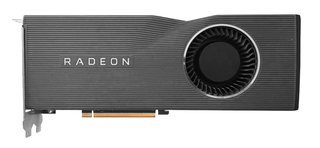
A graphics processing unit (GPU) is a specialized electronic circuit initially designed to accelerate computer graphics and image processing. After their initial design, GPUs were found to be useful for non-graphic calculations involving embarrassingly parallel problems due to their parallel structure. Other non-graphical uses include the training of neural networks and cryptocurrency mining.

Radeon is a brand of computer products, including graphics processing units, random-access memory, RAM disk software, and solid-state drives, produced by Radeon Technologies Group, a division of AMD. The brand was launched in 2000 by ATI Technologies, which was acquired by AMD in 2006 for US$5.4 billion.
Unified Video Decoder is the name given to AMD's dedicated video decoding ASIC. There are multiple versions implementing a multitude of video codecs, such as H.264 and VC-1.
The Evergreen series is a family of GPUs developed by Advanced Micro Devices for its Radeon line under the ATI brand name. It was employed in Radeon HD 5000 graphics card series and competed directly with Nvidia's GeForce 400 series.

The Northern Islands series is a family of GPUs developed by Advanced Micro Devices (AMD) forming part of its Radeon-brand, based on the 40 nm process. Some models are based on TeraScale 2 (VLIW5), some on the new TeraScale 3 (VLIW4) introduced with them.

The Radeon 200 series is a series of graphics processors developed by AMD. These GPUs are manufactured on a 28 nm Gate-Last process through TSMC or Common Platform Alliance.
The graphics processing unit (GPU) codenamed the Radeon R600 is the foundation of the Radeon HD 2000/3000 series and the FireGL 2007 series video cards developed by ATI Technologies.
The graphics processing unit (GPU) codenamed Radeon R600 is the foundation of the Radeon HD 2000 series and the FireGL 2007 series video cards developed by ATI Technologies. The HD 2000 cards competed with nVidia's GeForce 8 series.
Radeon X800 is a series of graphics cards designed by ATI Technologies Inc. introduced in May 2004.
The Radeon X700 (RV410) series replaced the X600 in September 2004. X700 Pro is clocked at 425 MHz core, and produced on a 0.11 micrometre process. RV410 used a layout consisting of 8 pixel pipelines connected to 4 ROPs while maintaining the 6 vertex shaders of X800. The 110 nm process was a cost-cutting process, designed not for high clock speeds but for reducing die size while maintaining high yields. An X700 XT was planned for production, and reviewed by various hardware web sites, but was never released. It was believed that X700 XT set too high of a clock ceiling for ATI to profitably produce. X700 XT was also not adequately competitive with nVidia's impressive GeForce 6600GT. ATI would go on produce a card in the X800 series to compete instead.

The R300 GPU, introduced in August 2002 and developed by ATI Technologies, is its third generation of GPU used in Radeon graphics cards. This GPU features 3D acceleration based upon Direct3D 9.0 and OpenGL 2.0, a major improvement in features and performance compared to the preceding R200 design. R300 was the first fully Direct3D 9-capable consumer graphics chip. The processors also include 2D GUI acceleration, video acceleration, and multiple display outputs.

The Radeon 300 series is a series of graphics processors developed by AMD. All of the GPUs of the series are produced in 28 nm format and use the Graphics Core Next (GCN) micro-architecture.
The Radeon 400 series is a series of graphics processors developed by AMD. These cards were the first to feature the Polaris GPUs, using the new 14 nm FinFET manufacturing process, developed by Samsung Electronics and licensed to GlobalFoundries. The Polaris family initially included two new chips in the Graphics Core Next (GCN) family. Polaris implements the 4th generation of the Graphics Core Next instruction set, and shares commonalities with the previous GCN microarchitectures.

The Radeon 500 series is a series of graphics processors developed by AMD. These cards are based on the fourth iteration of the Graphics Core Next architecture, featuring GPUs based on Polaris 30, Polaris 20, Polaris 11, and Polaris 12 chips. Thus the RX 500 series uses the same microarchitecture and instruction set as its predecessor, while making use of improvements in the manufacturing process to enable higher clock rates.

The Radeon RX 5000 series is a series of graphics processors developed by AMD, based on their RDNA architecture. The series is targeting the mainstream mid to high-end segment and is the successor to the Radeon RX Vega series. The launch occurred on July 7, 2019. It is manufactured using TSMC's 7 nm FinFET semiconductor fabrication process.

RDNA is a graphics processing unit (GPU) microarchitecture and accompanying instruction set architecture developed by AMD. It is the successor to their Graphics Core Next (GCN) microarchitecture/instruction set. The first product lineup featuring RDNA was the Radeon RX 5000 series of video cards, launched on July 7, 2019. The architecture is also used in mobile products. It is manufactured and fabricated with TSMC's N7 FinFET graphics chips used in the Navi series of AMD Radeon graphics cards.

RDNA 2 is a GPU microarchitecture designed by AMD, released with the Radeon RX 6000 series on November 18, 2020. Alongside powering the RX 6000 series, RDNA 2 is also featured in the SoCs designed by AMD for the PlayStation 5, Xbox Series X/S, and Steam Deck consoles.

The Radeon RX 6000 series is a series of graphics processing units developed by AMD, based on their RDNA 2 architecture. It was announced on October 28, 2020 and is the successor to the Radeon RX 5000 series. It consists of the entry-level RX 6400, mid-range RX 6500 XT, high-end RX 6600, RX 6600 XT, RX 6650 XT, RX 6700, RX 6700 XT, upper high-end RX 6750 XT, RX 6800, RX 6800 XT, and enthusiast RX 6900 XT and RX 6950 XT for desktop computers; and the RX 6600M, RX 6700M, and RX 6800M for laptops. A sub-series for mobile, Radeon RX 6000S, was announced in CES 2022, targeting thin and light laptop designs.

The Radeon RX 7000 series is a series of graphics processing units developed by AMD, based on their RDNA 3 architecture. It was announced on November 3, 2022 and is the successor to the Radeon RX 6000 series. Currently AMD has announced and released seven graphics cards of the Radeon RX 7000 series: RX 7600, RX 7600 XT, RX 7700 XT, RX 7800 XT, RX 7900 GRE, RX 7900 XT, and RX 7900 XTX. AMD officially launched the RX 7900 XT and RX 7900 XTX on December 13, 2022. AMD released the RX 7600 on May 25, 2023. AMD released their last two models of the RDNA 3 family on September 6, 2023; the 7700 XT and the 7800 XT. As of January 2024, AMD have also released the RX 7600 XT and the RX 7900 GRE.











